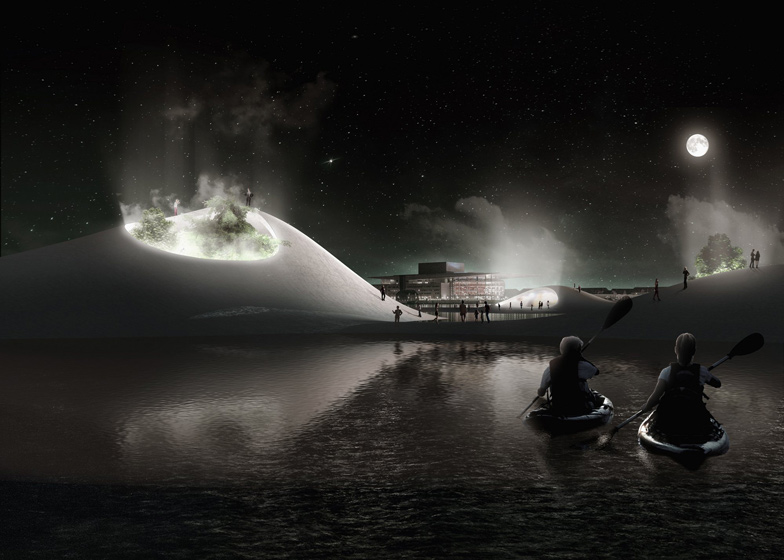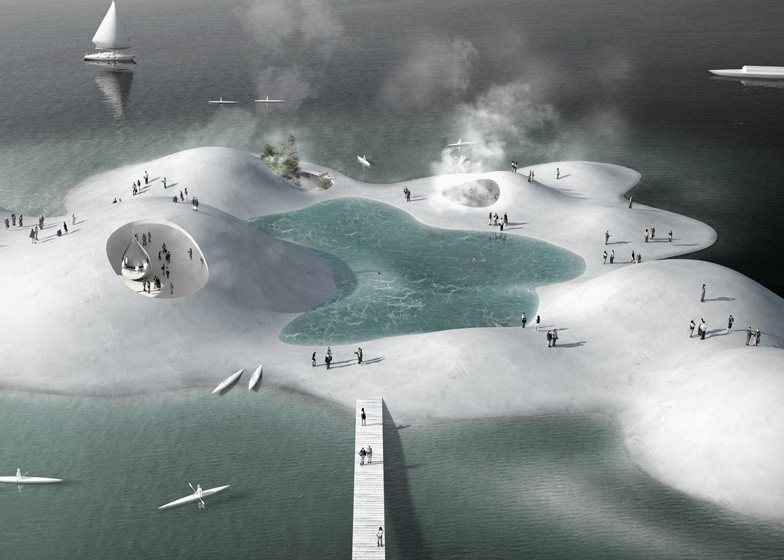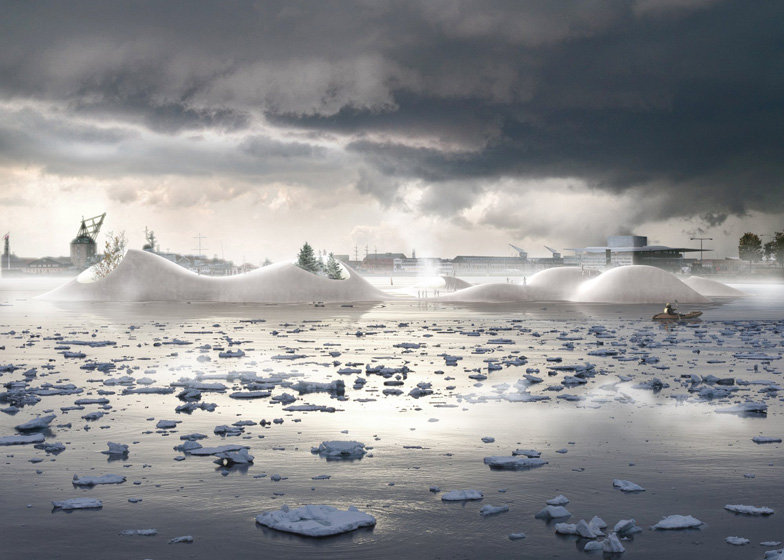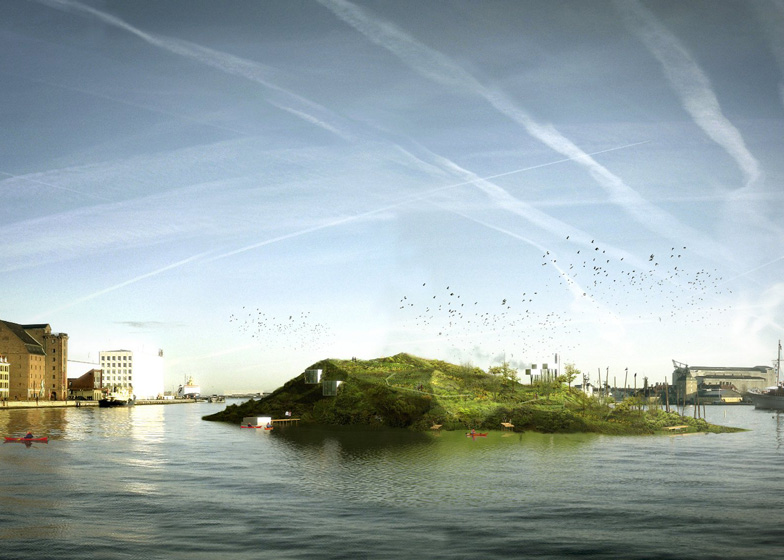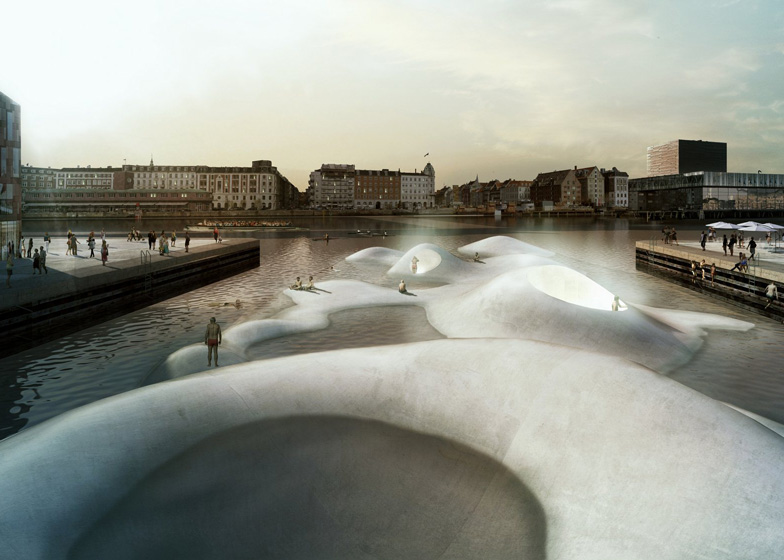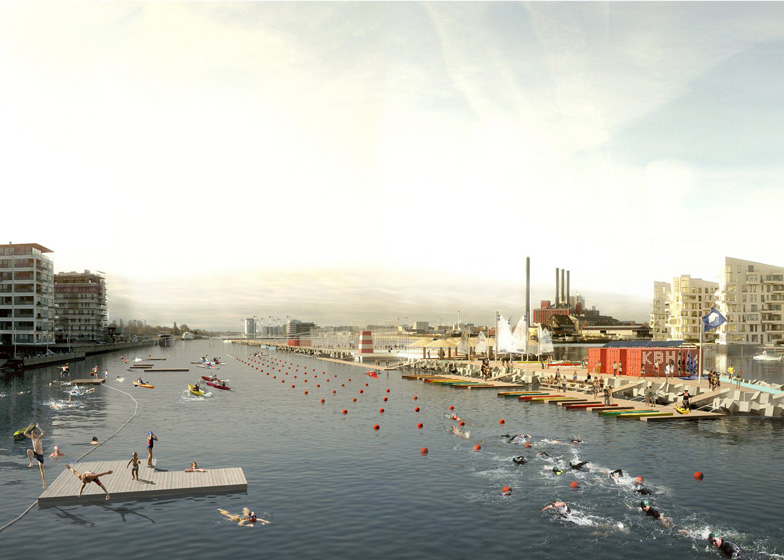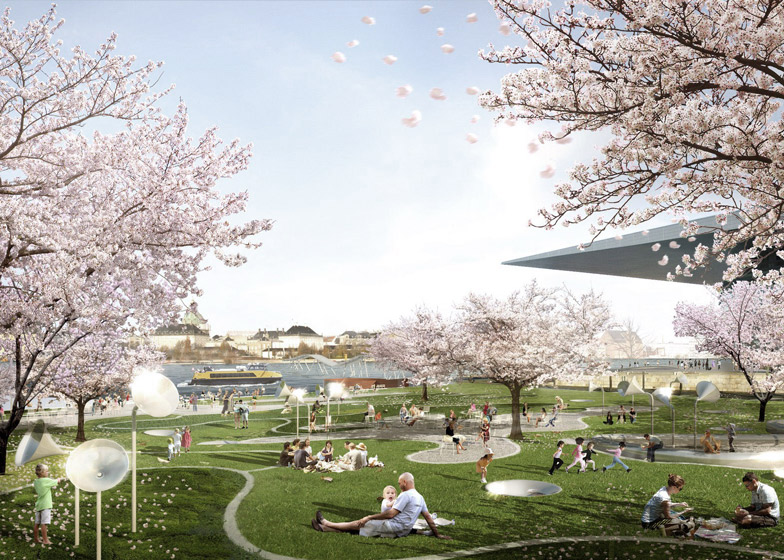Danish architects Tredje Natur and PK3 have designed a series of artificial islands that will transform Copenhagen's harbour into a recreational area filled with wildlife and water sports (+ slideshow).
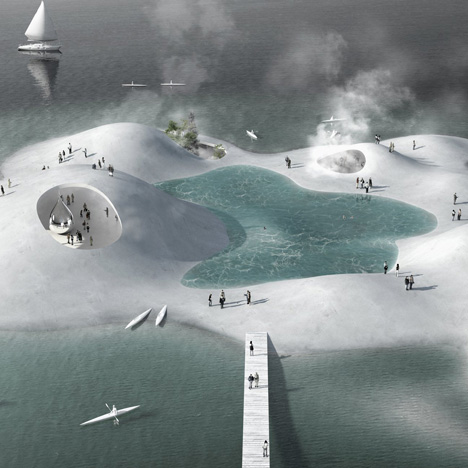
Above: House of Water
Commissioned by the city's planning department, Tredje Natur and PK3 were inspired by Copenhagen's long history of artificially constructed islands, many of which served as a navy base in the sixteenth and seventeenth centuries, to create the masterplan.
Entitled Blue Plan, it covers five zones in and around the harbour and is conceived as a public recreation area for residents and tourists, as well as an educational facility.
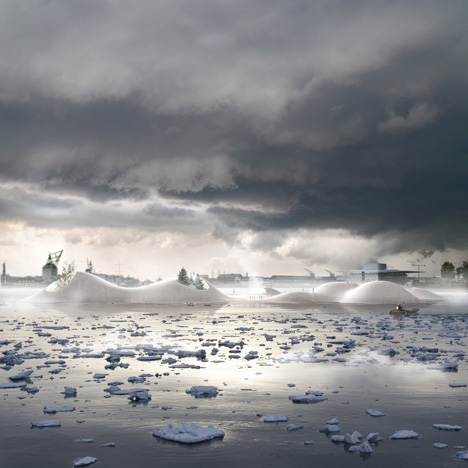
Above: House of Water
"The harbour bath is now so clean that the tourists and citizens of the city can both bathe and fish here - a privilege only a few large harbour cities in the world share," explained Tredje Natur's Flemming Rafn Thomsen and Ole Schrøder, describing how they imagine the space as "a showcase for Danish water technology".
The first of the five zones is to be named House of Water and will comprise softly curving concrete islands, accessed by a traditional wooden jetty.
Above: Bird Island
Fugleøen, or Bird Island, will be a plant-covered islet that birds, small animals and insects can use as a habitat. "[This] island will be the obvious destination for bird lovers, angling enthusiasts, shell collectors, biologists and school classes to be taught biology, history and geography," said the architects.
Above: Krøyer’s Puddle
The third zone will be Krøyer’s Puddle, a harbour bath with heated inlet pools and sauna caves, while the fourth planned area is Operaparken, a temporary park outside the Royal Opera House where music will be projected for all to hear.
Above: Operaparken
Sportsøen is designed as a water sports island in the centre of the harbour and will feature scuba diving, swimming and kayaking.
Above: Sportsøen
"Research shows that there is a clear connection between the physical activity level of humans and the experienced accessibility to nature – the easier the experienced accessibility to nature is, the bigger desire for physical activity. Other research indicates that stays in nature have a positive influence on the mental health of humans and on the reduction of stress," said the architects.
Above: House of Water
Floating pathways and bridges will connect the new islands, and the architects will now work up a detailed urban analysis to move the project into the next stage of development.
Above: Copenhagen aerial photograph
Copenhagen's harbour makes up almost a third of the entire city and is set already set to change shape in the near future, following the construction of bridges and quays by Danish foundation Realdania and the opening of 3XN's Blue Planet aquarium.
See more stories about Copenhagen »
Here's some more information from Tredje Natur:
Blue Plan - An urban spatial perspective on the Copenhagen Harbor
Ambition
TREDJE NATUR, PK3 and the Municipality of Copenhagen have an ambition to make the Copenhagen Harbor a living, accessible, useful and recreational area in Copenhagen. The plan for this ambition, we call ”Blue Plan”. Blue Plan enters the development of the harbor into the historic development of the city but also showcases the contemporary recreational potentials and utility function of the harbor. With Blue Plan we wish to give the harbor of Copenhagen back to the Copenhageners!
Blue Knowledge
Copenhagen is founded by its central location by the water and the resources connecting to it. The plan is to reorient the city life and functions towards the harbor and through this, strengthen the recreational benefits of the place to the joy of the citizens, merchants and tourists of Copenhagen. This will, among other things, take place by reintroducing the city’s long tradition for creating new islands and islets. The islets will create new connection, both physically and between the citizens within, increase awareness of the nature we all depend on and they will contribute to branding the highly developed knowledge in Danish water technology.
Denmark is at the front when it comes to knowledge about water. In this way, Blue Plan makes the Copenhagen Harbor a presentation of the Danish water-technological successes and the know-how that connects to it. The harbor bath is now so clean that the tourists and citizens of the city can both bathe and fish here – a privilege only a few large harbor cities in the world share. By creating an accessible, recreational and experiment-oriented blue urban space, the Copenhagen Harbor can thus make itself a showcase for Danish water-technology.
Waterload on the Harbor
The climate is changing. We can forecast more short but violent rain storms like the ones Copenhagen has experienced in the past two summers. At the same time, rising ocean levels is an internationally recognized problem which in particular threatens the urbanized areas. Thus, the harbor is under pressure from both sides as the rain water must be able to exit into the harbor and at the same time making sure that the rising harbor water does not run into the city. The climate safeguarding of Copenhagen is of a previously unseen proportion and a new generation of architects are asking how the allocated money also can lead to a greener and more eventful city. In conjunction with the new water and climate adaptation technologies, the architects work to ensure a more coherent and eventful Copenhagen.
The direct experience of the possibilities the technologies create for the recreational activities will promote the branding of the city and the Danish know-how. At the same time the useful and recreational blue urban spaces can function as a reminder to us Danes of the invisible consummation we have of the scarce water resources of the world – not in the form of a pointing finger but by making it apparent that we in Denmark actually can make a difference here and now.
Strategy – Water Surfaces, Connections and Edges
Blue Plan is thus a tale of the harbor of the future where the possibilities of the water and the recreational benefit carry the leading role. This tale is unfolded in the plan through three concepts that will each participate in qualifying the harbor and water potentials:
Water surfaces – the most important quality of the harbor is the water. A central concept in Blue Plan is to create opportunities to interact with the water by creating safety and room for a number of different water activities and experimental offers such as walks on the bottom of the harbor in a network of glass walkways or biology classes under the surface in glass bells.
Edges – another concept that will strengthen the recreational and useful role of the water is a cultivation of the edges between water and land. The distance between the edge of the quay and the surface must be reduced and the direct accessibility developed. This must happen by the creation of new islets and islands in the harbor, remodeling edges to stairs, creating stone quays or establishing floating bridge and walkway systems on the water surface.
Connections – the third and last concept is about qualifying the connections in, along and across the harbor. The course of the harbor is in many places disrupted and the visitors are forced to move back and forth in the same path instead of around. By strengthening the harbor connections, possibilities are created for more coherent, eventful and circular patterns of movement on the harbor. This can for example happen by connecting Nordre Toldbod and Langelinje so the promenade becomes a circular walkway, by creating new islands in the harbor that can create life and movement across the water and by creating dynamic and varied walking paths extending from the upcoming four bicycle and pedestrian bridges.
From HAFN to CPH
The earliest traces of urban development around Copenhagen can be dated back to approx. year 700 and consists of various remnants of boating bridges found by Gammel Strand and Kongens Nytorv. But the foundation for the merchant town of Copenhagen was laid about 1000 years ago. At that time the area was still mostly consisting of moist tidal meadows and low islets – a moraine formation shaped by the latest ice age providing shelter for a humble trade center for the trade between Denmark and Scania. Around year 1100, King Valdemar the Great delegates ”Hafn”, as the city was called, to the bishop Absalon of Roskilde.
Hereafter, the development of the city gains speed. In a short amount of time Copenhagen grows tenfold because of the rising sales of fish, the easy access to transport by sea and the advantageous location in between Roskilde and Scania. Copenhagen is now center of trade in the area.
Concurrently with the growth of Copenhagen and the city becoming an important power center, the Copenhagen harbor is narrowed. From the 1550’s and onwards a series of artificial islands and islets were created such as Slotsholmen, Bremerholmen, Nyholm, Frederiksholm, Arsenaløen and Dokøen which all served as base for navy activities. In 1617 Christian IV gets the acceptance of the Council to found a new town in the harbor, that of Christianshavn. Other examples of artificially created islands and islets in the Copenhagen Harbor are Trekroner, Kastellet, Teglholmen and Sluseholmen.
A Blue Urban Space Perspective on the Copenhagen Habor
Copenhagen is founded because of its central location by the water and the resources connecting to it. With Blue Plan TREDJE NATUR, PK3 and the Municipality of Copenhagen wishes to reorient the city life and functions towards the harbor and through this, strengthen the recreational benefits of the place to the joy of the citizens, merchants and tourists of Copenhagen. This will, among other things, take place by reintroducing the city’s long tradition for creating new islands and islets. The islets will create connection across, both physically and between the citizens within, increase awareness of the nature we all depend on and they will contribute to branding the highly developed knowledge in water technology of Denmark.
The recreational potentials of the harbor
The Copenhagen Harbor today make up – despite the many backfillings of the harbor fairway – still almost a third of the total area of Copenhagen. Yet, only a few areas are accessible to the citizens of Copenhagen and even fewer appears as recreational areas which encourage stay. The harbor is today quite oppositely strongly dominated by big scale company domiciles and hotels with the harbor bath on Islands Brygge and the area around Skuespilhuset and Ofelia Beach as a few of the exceptions. With Blue Plan the Copenhagen Harbor is transformed into a blue and recreational urban space adapted to human scale. An urban space with a multifarious animal and plant life which invites to a stay in and by the water creates possibilities for different forms of activity and offers sensuous places of sojourn.
Blue Plan thus puts action behind knowledge and enters the development of the Copenhagen Harbor in the fight for a better and more health-promoting urban environment. Research shows that there is a clear connection between the physical activity level of humans and the experienced accessibility to nature – the easier the experienced accessibility to nature is, the bigger desire for physical activity. Other research points towards that stays in nature have a positive influence on the mental health of humans and on the reduction of stress. The recreational visions of Blue Plan for the harbor can in this way carry a decisive role in heightening the general wellbeing and level of health.
The harbor as a contemporary commons
In the book ”Fælledskab” (common-ity), Tor Nørretranders and Søren Hermansen describe how the community connection to the place, the intimate and social life slowly has been lost in the contemporary society. According to Nørretranders and Hermansen, the ”eye-level- perspective” has disappeared in our cities and decisions have been removed from those they in fact influence. If this development is to be turned around and humans yet again shall experience a togetherness with, care and ownership of the local area, society must promote and care for an already growing trend – that of the fælledskab or common-ity. Common-ity is described in the book as a combination of the two words commons and community. Communities are valuable according to Nørretranders and Hermansen but they need a task, a purpose that binds it together and strengthens it – a commons.
200 years ago, commons were open grass areas where everyone could send their animals to graze freely. In the book the common is reintroduced as a resource and as a means for reconnecting with the intimate, local and social life. Examples of contemporary commons can be communities of food supplies, child caring, yard maintenance, wireless networks, sports arenas and green energy supplies. With Blue Plan, TREDJE NATUR, PK3 and the Municipality of Copenhagen wishes to make the Copenhagen Harbor into a contemporary commons by creating a series of purposes that different types of communities can form around. This could for example be by creating new and better possibilities for fishing, sport, water activities, bird sanctuary, apiculture, teaching and communication. By cultivating the common-ities on the harbor, Blue Plan can contribute to increasing the togetherness and co-ownership in the city.
Benefits of the harbor
Denmark is at the front when it comes to knowledge about water. In this way, Blue Plan makes the Copenhagen Harbor a presentation of the Danish water-technological successes and the know-how that connects to it. The harbor bath is now so clean that the tourists and citizens of the city can both bathe and fish here – a privilege only a few large harbor cities in the world share. By creating an accessible, recreational and experiment-oriented blue urban space, the Copenhagen Harbor can thus make itself a showcase for Danish water-technology – a technology market that globally has an annual turnover of a four digit billion figure (in Danish Kroners).
Five new blue urban areas
Blue Plan specifically presents four areas that will strengthen the recreational value of the harbor. These five areas we call House of water, Fugleøen, Krøyers Pøl, Sportsøen and Operaparken and are all created by making room for the great visions in the name of pragmatics through the game “what if…” Way too much architecture has wrestled its way out of great visions in the name of pragmatics but in the work with Blue Plan we have put the energy and drive that lies in these visions to use in order to, through this, create a rethinking and different urban space. The game is in this way used as a can opener for all of the conserved ideas and realizable dreams many share for the harbor and urban space.
The result of this game with visions is vitalizing, sensuous, playful and hybrid blue urban spaces which do not limit themselves by traditional understandings of the harbor role and look. Urban spaces, which both draws on the historic heritage of the city and makes room for new forms of use and life.
HOW - House of Water
”The wish of a better reputation will not create a better country but create a better country and it will automatically transmit a better reputation" has been said by one of the world’s leading experts in national branding. Or said with other words; strong brands are created by meaningful visions, through actions and by interacting with its surroundings. And that is the ambition of the Rethink Water-project.
Imagine if the Danish water-businesses worked together to create a House of Water on the Copenhagen Harbor? A place where all visitors could engage in the urban space and at the same time learns about the global water challenges and solutions. Knowledge, water and nature are melted together in a new type of contextual architecture that gives more to the city and the harbor than it takes. A remarkable design in soft concrete folds creating both room and landscape to interact with the water.
Fugleøen (Bird Island)
Imagine if a bird island was in the middle of the harbor. A green island surrounded by a stone reef that takes you back to the landscape that surrounded the first settlements in Copenhagen; an island where the plenty biodiversity and unregulated development of nature is the pivotal point.
Fugleøen is the dream of creating an unregulated island in the middle of the Copenhagen Harbor which can serve as a transmitter of the historic landscape that Copenhagen is built upon, which can attract a rich bird life and which can be used for experimenting with the local bio diversity. The island will be the obvious destination for bird lovers, angling enthusiasts, shell collectors, biologists and school classes to be taught biology, history and geography and for regular citizens who only wish to enjoy the possibility of the long afternoon sun and at the same time experience the unregulated nature in the middle of the Copenhagen Harbor.
Krøyers Pøl (Krøyer’s Puddle)
Imagine if the Copenhagen Harbor invited to a stay close by the water, in the water and under the surface. Krøyers Pøl is the dream of a performative area which combines the next generation harbor bath with the utility function of the water.
Krøyers Pøl becomes, with its dynamic floating island sculpted in concrete, a contemporary interpretation of the city tradition of artificially created islands and islets. The floating islands which are to be placed outside of Nordatlantens Brygge, blurs the edges between water and land and creates new connections in the harbor, via raised isthmuses, between islands and quay areas. As next generation harbor bath, Krøyers Pøl offers itself as a blue urban space that allows the bathing people direct access to the harbor water surface, the possibility of bathing in small heated inlet pools and room for relaxation between the hot stones of the sauna caves. But Krøyers Pøls closeness to the water also creates unique opportunities to explore the utility function of the harbor.
A part of Blue Plan is to transform the area around Krøyers Pøl into an attractive place for the many fish and plant varieties of the harbor. Combined with the direct access to the water surface, Krøyers Pøl can become an attractive place for angling, harvesting of water plant and fish farming. The location of the project right outside the world renowned Michelin restaurant noma will present the Copenhagen Harbor as a clean and attractive resource for many of the national and international guests of the restaurant. A harbor which supports the Nordic gastronomic ambition of minimal distance between soil and table – from the harbor to noma. With Krøyers Pøl the harbor is thus made into a display window of the Nordic ingredients and the sustainable development of Copenhagen.
Sportsøen (Sports Island)
Imagine if there was a sports island in the middle of the harbor. An island where the attraction of the harbor, the water surface, is bursting with activities which invites the citizens out onto the water and creates new eventful sports opportunities right there close to nature.
Sportsøen is the dream of continuing the Copenhagen historical heritage in a contemporary and activity based context which links the experience of nature and sport close together. By creating a new island in the harbor which offers facilities to a wide range of water sports, the island qualifies the water surrounding it. Sportsøen will pull the life down into the harbor and make it an attractive place for scuba divers, swimmer, jumpers, kayakers, winter bathers and other forms of water sport enthusiasts. The “soft” users of the harbor need a secure place where they do not have to fear the large fast-moving boats and harbor busses. This is solved by placing Sportsøen in the middle of the harbor fairway which creates a natural division with space for the functional use of the harbor on one side and the recreational use on the other.
Operaparken (Opera Park)
Imagine if the rich sounds of the Royal Opera House were audible in an opera park that connects the Royal Opera House to its surroundings. A sound park that offers seducing, sensuous musical experiences on the edge of the harbor.
Operaparken is the dream of a temporary recreational use of the large grass area by the Royal Opera House. A dream of taking the fine culture to the masses by turning the inside out of the Royal Opera House and provide the visitors of the park with the opportunity to listen to the enchanting and dramatic world of the opera. Operaparken, with the music, its blossoming cherry trees, magnolias and plants which can live in the salty microclimate, will offer a sensuous wholesome experience out of the ordinary.
The temporary park will also work to create a natural connection between the Royal Opera House and its surroundings – a connection which can invite new groups of users inside a world that otherwise might appear strange. In the coming years, new connections are formed across Copenhagen via the four new bike and pedestrian bridges which are to connect Nyhavn with Christianshavn and Holmen. Operaparken will, as an extension of these, make up a new public destination which can attract life to the area and support the work of combining the city closer across the harbor.

